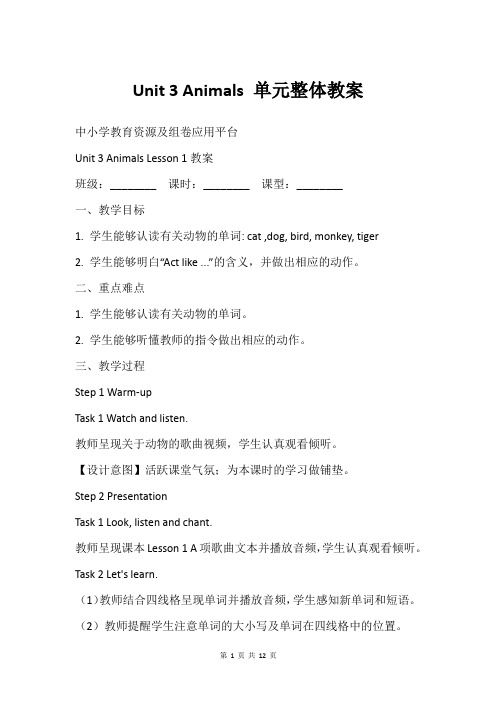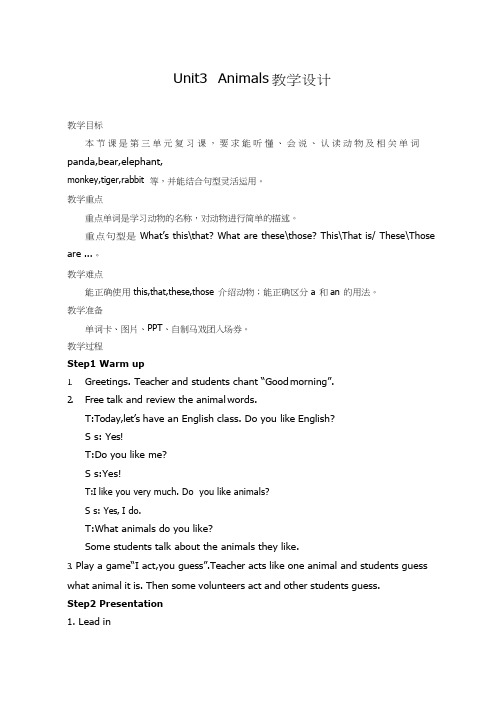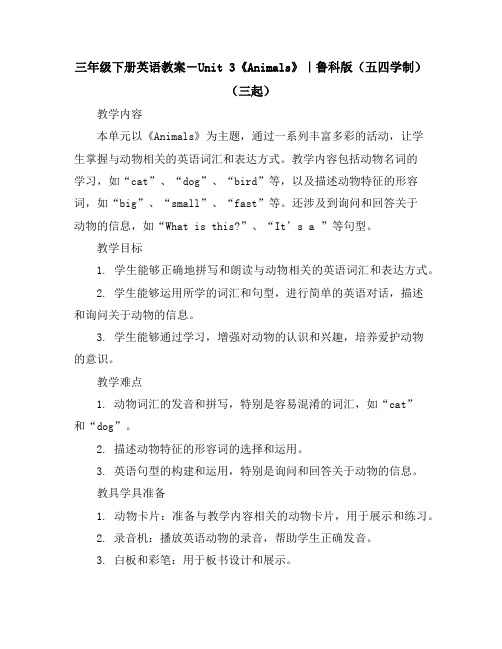UNIT3 Animals 导学案
- 格式:docx
- 大小:21.11 KB
- 文档页数:10

Unit 3 Animals(the fourth period)—何佳静Analyze the tezching materialThis is the unit 3 of this book. The main topic is about the animals that we can see in the zoo. We are going ro learn the words of the animals and anwser some easy quetions.To improve the students abilities of comunicating.The target of this lessonAfter the class,the students can read the words of animals and these sentences clearly .After this class ,the students can use the words and the sentences to conmunicate with their classmates. To make the dialogue :We are going to the zoo. What animals do you want to see ? I want to see ....After the class ,the students know the animals is our friends.We should love and protect them.The key pointThe students can make the dialogue and ask their friends what animals do you want to see ?The difficult pointLet the students can describe the animals and use the dialoguein daily life.Prepare for classthe recorder ,the cardsTeaching proceduresStep 1 Greetings(1)Devide the students into three groups : tiger team ; monkey team; panda team .(2)Sing the song :finger famliy song --zoo animals(In order to make the class living and catch the students’attention)Step 2 Review(1)Review these words that we have learned before. (elephant, tiger, horse, panda, monkey, cow ,sheep and so on.)(2)Review the sentence : what is your favourite animal? My favourite animal is the .....(In order to let the students pracitise more and make sure they can use the sentences to communicate with classmates ) (3)Play a game: I SAY YOU GUESSThe teacher describe the animals, and then the students guess what is it ?Eg. It is big. It is strong . It has long nose . It has big ears.What is it ? Ss: It is elephant .Eg . It is big . It is cute .It is black and white . It has small eyes . What is it ? Ss: It is panda .(In order to increase the Ss’s interests of learning English ,and prepare for the sentences that we will learn this lesson.)Step 3 Presentation(1)Show four pictures of Xi Shan ParkQ1 : Have you beet to Xi Shan Park ?(你们去过西山公园吗?)Q2: What animals are in Xi Shan Park ?We can see monkeys in Xi Shan Park.(2)We are going to the zoo. What animals do you want to see ? Eg. I want to see pandas.Ask some students to answer the question.(3)Pair work .Find your partner and ask each otherWhat animals do yo want to see ? I want to see .....(In order to make the Ss practise more , make sure they can read these sentences correctly and use the target language to communicate with others)(4)Listen the three news friends : what animals do they want to see ? (In order to prepare for the next part)(5)Show a picture of panda . T ask Ss What’s the panda like ? Ss: It is big .It is cute.... show a picture of pandas. T ask Ss What are the pandas like ? Change It is.... to They are ...They are cute.Use the same way to talk about elaphants , horses and tigers. ( 6) Take the horses and penguins as example . Show the target langusages:What animals do you want to see ?I want to see horses /penguins.Why ?They are fast ./ cute and small.Step 4 Practise(1)Give Ss a list about the dialogue in this book Page 27. Listen the dialogue what animals do they want to see ?and fill the list. We are going to the zoo.A: Bill wants to see______. They are _______.B: Binbin wants to see _____. They are ______.C: Amy wants to see_______. They are _______.(In order to train Ss’ ablity of listening ,writing and prepare for group working.)(2)Group work (with listening music)Four students make a group to make the dialogueA: We are going to the zoo.What animals do you want to see ? B: I want to see ____ . They are _____.C: I want to see ____ . They are _____.D: I want to see ____ . They are _____.(In order to make the Ss to grasp the target language , make sure they can read and use them correctly. Increase Ss’ ability of speaking )(3)Show timeStep 4 Sum up(1)Sum up(review the knowledge that we have learned this lesson ,to make sure the Ss can talk babout the animals and the target language in English )(2)To educate the Ss tp love animals. Animals are our friends,we should love and protect them .Step 5 HomeworkRead the dialogue three times .Blackboard Design:-What animals do you want to see ?-I want to see ________.-Why ?-They are______.江油市武都镇阳亭中心小学校2018年11月20日。

Unit3第1课时教学设计[内容来源]人民教育出版社(一起点)五年级上册Unit3 Animals[课时]第1课时一、教学目标1.能够掌握以及熟练使用animal, elephant, panda, horse, cow, pig; sheep, bee, farm和fast十个单词。
2.能够熟练地操练功能句I want to see....,并对个人喜欢的动物进行简单的描述They are...3.能够根据语境从上述单词中选择恰当的词填空。
二、创新设计1、教学活动的设计符合学生的认知规律:从旧知到新知,从具体到抽象,从简单到复杂。
2、教学活动的设计注重与学生的生活实际相结合,注重激发学生的学习兴趣。
3、活用猜词、转盘游戏,创设语言运用的情景,提高教学的趣味性。
三、教学方法讨论法,探究法, 游戏法四、重点难点1、熟练地操练功能句I want to see....2、对个人喜欢的动物进行简单的描述They are ...五、教学过程(一)导入1、师生打招呼,然后播放视频,围绕视频中看到到的动物与学生进行交谈,问问学生: What did you see in the video?引导学生回答,并出示本课标题《Animals》2、Play a guessing game : review words about animals教师提问:Do you like animals? What animals do you know?Let’s review some animals.(panda, elephant, horse, cow, pig, sheep, bee)教师描述动物的特征:It is black and white, It is cute,What is it?学生根据教师的描述,猜测动物名称。
然后,由一名学生读谜语或是学动物的叫声,其余学生猜测动物名称,教师有针对性地进行纠音。
[设计意图]通过谜语的方式引导学生复习关于动物的单词,有利于激发学生的学习热情,以有趣的形式帮助学生激活旧知,为接下来的句型学习做好语言准备。

Unit 3 Animals 单元整体教案中小学教育资源及组卷应用平台Unit 3 Animals Lesson 1教案班级:________ 课时:________ 课型:________一、教学目标1. 学生能够认读有关动物的单词: cat ,dog, bird, monkey, tiger2. 学生能够明白“Act like ...”的含义,并做出相应的动作。
二、重点难点1. 学生能够认读有关动物的单词。
2. 学生能够听懂教师的指令做出相应的动作。
三、教学过程Step 1 Warm-upTask 1 Watch and listen.教师呈现关于动物的歌曲视频,学生认真观看倾听。
【设计意图】活跃课堂气氛;为本课时的学习做铺垫。
Step 2 PresentationTask 1 Look, listen and chant.教师呈现课本Lesson 1 A项歌曲文本并播放音频,学生认真观看倾听。
Task 2 Let's learn.(1)教师结合四线格呈现单词并播放音频,学生感知新单词和短语。
(2)教师提醒学生注意单词的大小写及单词在四线格中的位置。
【设计意图】学习本单元重点单词拼写和发音。
Task 3 Listen and repeat.(1)教师呈现本单元全部单词并播放音频,学生模仿朗读。
教师注意纠正学生发音。
(2)教师采取多种方式让学生读单词,如同桌读、分组读和接龙读等。
【设计意图】纠正学生发音。
Task 4 Listen and chant again.教师再次呈现课本Lesson 1 A项歌曲并播放音频,学生认真听并跟唱。
【设计意图】让学生在歌曲中感受新单词,加深印象。
Step 3 PracticeTask 1 Listen and guess.(1)教师播放动物叫声的音频,学生认真听并尝试猜出是什么动物。
(2)教师呈现答案,并播放单词对应的音频,学生模仿朗读。
Task 2 Missing game.(1)教师呈现动物图片,使图片逐一消失。

Unit3 Animals 教学设计教学目标本节课是第三单元复习课,要求能听懂、会说、认读动物及相关单词panda,bear,elephant,monkey,tiger,rabbit 等,并能结合句型灵活运用。
教学重点重点单词是学习动物的名称,对动物进行简单的描述。
重点句型是What’s this\that? What are these\those? This\That is/ These\Those are ...。
教学难点能正确使用this,that,these,those 介绍动物;能正确区分a 和an 的用法。
教学准备单词卡、图片、PPT、自制马戏团入场券。
教学过程Step1 Warm up1.Greetings. Teacher and students chant “Good morning”.2.Free talk and review the animal words.T:Today,let’s have an English class. Do you like English?S s: Yes!T:Do you like me?S s:Yes!T:I like you very much. Do you like animals?S s: Yes, I do.T:What animals do you like?Some students talk about the animals they like.3.Play a game“I act,you guess”.Teacher acts like one animal and students guess what animal it is. Then some volunteers act and other students guess.Step2 Presentation1.Lead inT:Let’s watch a video about animals and you can answer the question:Where are they?Students watch the video and answer :“They’re in circus(马戏团).”T:What do you know about circus(马戏团)?Students talk about circus.T:Do you want to watch the performance in the circus? Try your best to get a ticket for the performance.Are you ready? Let’s go!2.Words and Sentence revision(1)Teacher shows the picture of panda,and asks:“What’s this?” Students answer: “It’s a panda.”The fastest voice can get a ticket. Then passes the picture and asks“What’s this?” one bye one.Teacher shows the smaller picture of panda,and says:“It looks small.Because it’s far away from us.So I will ask What’s that?”The answer is same to What’s this.教师强调this 和that 的区别:this means something close to us, that means something far away from us.(2)Guessing game.“I'm very clever.I'm very funny.I can walk using two legs.I can ride a bike.” Guess wh at animal it is. Students say the animals name freely.Whose answer is right can get a ticket. Then passes the picture and asks“What’s this?” one bye one.Teacher shows the smaller picture of monkey,and asks:“ What’s that?”Students answer: “It’s a monkey.”The answer is same to What’s this.(3)创设魔术情境。

三年级下册英语教案-Unit 3《Animals》|鲁科版(五四学制)(三起)教学内容本单元以《Animals》为主题,通过一系列丰富多彩的活动,让学生掌握与动物相关的英语词汇和表达方式。
教学内容包括动物名词的学习,如“cat”、“dog”、“bird”等,以及描述动物特征的形容词,如“big”、“small”、“fast”等。
还涉及到询问和回答关于动物的信息,如“What is this?”、“It’s a ”等句型。
教学目标1. 学生能够正确地拼写和朗读与动物相关的英语词汇和表达方式。
2. 学生能够运用所学的词汇和句型,进行简单的英语对话,描述和询问关于动物的信息。
3. 学生能够通过学习,增强对动物的认识和兴趣,培养爱护动物的意识。
教学难点1. 动物词汇的发音和拼写,特别是容易混淆的词汇,如“cat”和“dog”。
2. 描述动物特征的形容词的选择和运用。
3. 英语句型的构建和运用,特别是询问和回答关于动物的信息。
教具学具准备1. 动物卡片:准备与教学内容相关的动物卡片,用于展示和练习。
2. 录音机:播放英语动物的录音,帮助学生正确发音。
3. 白板和彩笔:用于板书设计和展示。
4. 动物模型或玩具:用于直观展示和吸引学生的注意力。
教学过程1. 导入:通过展示动物卡片,引导学生说出动物的英文名称,激发学生的学习兴趣。
2. 新授:教授新的动物词汇和描述动物特征的形容词,通过录音机播放正确的发音,让学生跟读并模仿。
3. 练习:进行小组活动,让学生运用所学的词汇和句型,进行简单的英语对话。
4. 巩固:通过游戏或竞赛,巩固学生对动物词汇和句型的掌握。
板书设计1. 在白板上,用彩笔书写本节课的重点词汇和句型,突出显示。
2. 用图表或思维导图的方式,展示动物词汇的分类和描述动物特征的方法。
3. 通过板书,展示英语句型的构建和运用。
作业设计1. 书面作业:完成练习册上的相关练习,巩固所学知识。
2. 口头作业:与家长或同学进行英语对话,描述和询问关于动物的信息。

Unit3 Fun Time教学设计【内容来源】人民教育出版社〔一起点〕五年级|上册Unit3 Animals【课时】Fun Time一、教学目标1. 了解关于濒临灭绝|的稀有动物的状况,懂得保护动物的意义.2. 引导学生制作一本关于动物的小书.3. 欣赏并学唱歌曲.二、教学建议A. Good to know.1. 热身导入(1) 播放C局部的歌曲.(2) 词汇复习全体学生朗读教学卡片上的词汇,然后随机让学生抽取动物卡片,并对卡片上的动物进行描述,其他同学猜一猜是哪种动物.2. 师生交流,读前质疑教师先出示一些学生熟悉的动物图片,并描述他们的近况,由此引出本课关于瀕临灭绝|的动物的话题,如:Pandas are our national animals. They are ... They eat ... They are cute. But they are in danger now. Do you know what other animals are in danger now 然后学生进行头脑风暴活动,同时教师板书学生提到的动物名字.3. 借助图片,引发思考(1) 教师出示藏羚羊和雪豹的图片,提问:What are they 引出词汇Tibetan antelope和snow leopard .(2) 引导学生思考:What do you know about them 并讨论发言.(3) 引发学生质疑:Where are Tibetan antelopes and snow leopards from What are they like What do they like to eat Why do people like to kill them等.4. 听短文,答复以下问题教师提出问题:What animals did you hear in the passage 学生听后答复以下问题.5. 默读短文,渗透阅读策略(1) 让学生默读语段,并标划重点信息:home, colour, appearance和food等.(2) 播放录音,学生进一步理解语段.(3) 再次播放录音,让学生跟读模仿.(4) 借助思维导图示范介绍藏铃羊的栖息地、外形和其他特征等.(5) 学生两人一组,各选择一种动物,根据思维导图互相进行描述.B. Let ,s make an animal book.1. 给出提示教师根据B项的提问,用关键词帮助学生理清思路,如Food和Activity .2. 学生两人一组,根据教师的提示,相互介绍自己喜欢的动物.3. 学生独立制作自己喜欢的动物的图卡,然后小组内介绍.4. 将全班制作的动物的图卡装订在一起,制作一本Animal Book供学生课下阅读.C. Let ,s sing.1. 第|一遍播放歌曲,让学生初步感知歌曲内容.2. 第二遍播放歌曲,让学生关注歌词中有动物的词汇.3. 教师将歌曲中难点歌词带着学生反复认读.4. 学生边听音乐边跟唱歌曲.三、备选活动【板书设计】【教学反思】第二课时Unit1 Story Time教学设计【内容来源】人民教育出版社〔一起点〕五年级|上册Unit1 Classmates【课时】Story Time一、教学目标1. 能够在教师的引导下,借助图片和其他阅读策略读懂本单元的故事,答复故事后的问题,并尝试复述故事.2. 能够通过学习小故事,了解每个人都有各自不同的性格特征,懂得欣赏他人的优点.二、教学建议1. 热身和导入(1) 热身教师出示几幅大小、形状不同的帐篷的幻灯片给学生欣赏.在欣赏中与学生交流:T: Do you know what these areS: They ,re tents. This tent is small, because it ,s for only one person. This tent is very big, because it ,s for three people ...教师还可以不断提问延伸讨论的话题.可参考的问题有:Have you got a tent Can you put up tents Does your family often use your tent when you go out or have picnics Have you been to camp and sleep in a tent for a night(2) 导入结合以上的讨论,导入故事的主题:This is a story about going camping. Let ,s read it.2. 呈现故事教师出示故事的第|一幅图片,引导学生对故事进行提问并预测故事内容:Who are they Where are they What will they do ...3. 图片环游,详细理解故事(1) 教师将故事图片打乱顺序放在黑板上.同时也发给每位学生一套故事图片.播放录音,学生听故事,按顺序在桌子上摆图片.(2) 第二遍听故事后,教师引导学生核对故事图片顺序.例如:I heard "in a boat〞, "teaching me how to fish〞, so I think this picture is number 2 ... 并按故事开展的顺序将黑板上的图片正确排列,学生也同时修改自己的图片顺序.(3) 教师发给每位学生一套故事文字,学生看图片找出对应的文段,将文段摆在对应的图片下.(4) 第三遍听故事,核对图文是否能对应.在此环节中教师对故事中学生不理解的词汇和表达等内容进行讲解,并提问:图1: There ,s a tall man wearing a pair of glasses. Who is he "I〞am at the camp, please look at the photo, who am I What do I look like图2: Jill is one of my classmates. What is she good at图3: What do we have for dinner While we are cooking dinner, what is Jack doing图4: Do they like eating the fish Do you eat out with your friends like them图5、6: After dinner, what do they do What do you think of John Can you sing and dance in front of your classmates like Mary图7、8: It is time for bed. What happens What do you think of Tom Do the students like their teacher, Mr White Do you like him ...学生答复以上问题,以了解他们是否理解了故事内容.(5) 学生自己完成课后练习,在问题旁边写出答案.(6) 请一名学生展示自己的答案,读给大家听.教师做指导,其他学生一起边听边用红色的笔修改自己的答案.4. 进一步熟悉故事(1) 教师播放录音,学生模仿录音跟读故事.(2) 请八名学生分别读每幅图片下的文段,教师指导朗读.5. 表演故事(1) 学生四人一组,分工合作复述故事.(2) 请几组学生展示小组合作成果,根据图片复述故事.三、备选活动教师可以选择适宜的环节放这个故事的动画版给学生欣赏. 【板书设计】【教学反思】。
Unit3 Animals(教学设计)人教版(新起点)英语五年级上册一、教学目标语言知识目标:学生能够听懂、会说、认读与动物相关的词汇,如tiger(老虎)、lion(狮子)、panda(熊猫)、monkey(猴子)、elephant(大象)等。
掌握句型“What's your favourite animal?(你最喜欢的动物是什么?)”“My favourite animal is...(我最喜欢的动物是……)”,并能在实际情境中准确运用。
了解一些动物的特征和生活习性。
语言技能目标:能够准确地用英语说出各种动物的名称,并描述其特征。
能够听懂关于动物的简单对话,并能根据对话内容进行回答和提问。
能够制作动物主题的手抄报,并能用英语介绍手抄报上的内容。
情感态度目标:培养学生对动物的热爱和保护意识。
通过小组活动和互动,增强学生的合作精神和交流能力。
激发学生对英语学习的兴趣,提高学习的积极性。
二、教学内容分析词汇:本单元的重点词汇是各种动物的名称,这些词汇与学生的日常生活密切相关,容易引起学生的兴趣。
这些动物词汇包括tiger(老虎)、lion(狮子)、panda(熊猫)、monkey(猴子)、elephant(大象)等。
每个词汇都代表着一种独特的动物形象和特征。
可以通过图片、实物、视频等方式帮助学生记忆这些词汇。
例如,图片展示是一种非常直观的方法。
教师可以准备高质量的动物图片,展示每种动物的外貌特征。
对于tiger,可以展示老虎威风凛凛的样子,它有着橙色的皮毛和黑色的条纹;lion 则可以展示狮子的王者风范,它的鬃毛非常显眼;panda 以其黑白相间的可爱模样吸引着学生,圆滚滚的身体和憨态可掬的表情让人印象深刻;monkey 活泼好动,有着长长的尾巴和机灵的眼神;elephant 体型庞大,有长长的鼻子和大大的耳朵。
通过这些图片,学生可以直观地认识各种动物,加深对词汇的理解和记忆。
实物展示也可以增强学生的学习兴趣。
小学英语Animals动物优秀教案一、教学内容本节课选自小学英语教材《新标准英语》第三册的Chapter 3《Animals》,详细内容包括:认识并掌握与动物相关的词汇,如:panda, tiger, elephant, monkey, lion等;学会使用What's this? It's a 询问和回答动物名称;通过听力练习和口语交流,提高学生对动物单词的识别和运用能力。
二、教学目标1. 让学生掌握本节课的动物词汇,并能正确发音。
2. 培养学生运用所学词汇进行问答交流的能力。
3. 提高学生对动物的认知,培养他们的观察力和想象力。
三、教学难点与重点教学难点:正确掌握动物词汇的发音和拼写。
教学重点:运用What's this? It's a 进行问答交流。
四、教具与学具准备1. 教具:PPT、动物卡片、录音机、磁带。
2. 学具:单词卡片、练习本、彩色笔。
五、教学过程1. 导入:通过PPT展示动物园的场景,引导学生谈论他们在动物园看到的动物,为新课的学习做好铺垫。
过程细节:教师提问,学生回答,共同回忆动物园的动物。
2. 新课展示:教师展示动物卡片,教授新单词,并进行发音示范。
过程细节:教师先展示卡片,让学生猜测动物名称,然后教授新单词,并进行发音示范,学生跟读。
3. 例题讲解:教师通过PPT展示例题,引导学生进行问答交流。
过程细节:教师提问,学生回答,进行角色扮演,巩固所学知识。
4. 随堂练习:学生分组进行单词卡片游戏,巩固所学动物词汇。
过程细节:每组学生轮流抽取卡片,读出动物名称,并进行问答交流。
5. 口语交际:学生分角色扮演,进行动物角色扮演游戏。
过程细节:学生扮演动物,进行问答交流,提高口语表达能力。
过程细节:教师通过提问、回答等方式,帮助学生巩固所学知识。
六、板书设计1. Animals2. 重点单词:panda, tiger, elephant, monkey, lion3. 重点句型:What's this? It's a七、作业设计1. 作业题目:完成课后练习册的相关练习。
Unit 3 AnimalsLesson 2程祎本单元教材分析本单元以Animal 为话题,呈现了10 个目标词汇:animal, elephant, panda, horse, cow, pig, sheep, bee, farm 和fast;让学生通过看、听和标号等途径来感知并学习这些词汇。
功能句:What’s your favourite animal?及答语:My favourite animal is the...通过小组活动,帮助学生操练句型和词汇,并体会词汇在交际情境中的运用。
本单元使用听力,对话,短文,story time来学习功能句和词汇,要求学生能够听、说、认读重点单词,根据问句写出答语。
学情分析学生学习程度较好,喜欢生动有趣的活动不太喜欢枯燥的机械重复跟读。
他们善于表达自己思想活跃。
在一年级孩子们已经学习相关动物的学习并接触过be going to …句型,为本单元的学习打下了基础。
语言能力目标1.词汇能够听懂会说animal, elephant, panda, horse, cow, pig, sheep, bee, farm,和fast十个单词,尝试借助拼读规律记忆单词,并能根据语境选择恰当的词填空。
2.主要句型能够在情景中理解并运用句型:What’s your favorite animal?及其回答:My favourite animal is the … 。
学习能力目标通过老师的引导,提高学生在听的过程中抓取关键信息的能力,培养学生通过观察图片,获取需要信息的能力。
学生可以在循序渐进的练习中将新旧知识融合运用,进行交流。
思维品质目标在读图的过程中获取有效信息。
文化品格目标能够懂得每个人都有自己的优点和缺点,正确认识自己,扬长避短。
一、教学目标1. 能够听懂、会说用来询问他人最喜欢什么动物的功能句:What’s your favourite animal?及其答语:My favourite animal is the ...,初步学会在恰当的情境中运用。
五年级上册英语教案-Unit 3《Animals》(Fun Time)|人教(新起点)一、教学目标1.能听懂、会说本单元有关动物名称和形容词。
2.能用所学动物名称和形容词,描述动物的特征。
3.能听懂、会说有关动物食品链的短语。
4.能运用所学短语,描述各种动物之间的关系。
5.能学习和理解动物的适应环境和生存状况。
二、教学重点1.学习动物的名称和形容词。
2.了解和学习动物的食品链及关系。
3.掌握动物的适应环境和生存状况。
三、教学难点1.理解动物之间的关系及其食品链。
2.学习适应环境及繁衍生息的必要因素。
3.学习理解生态环境保护对于动物保护的重要性。
四、教学过程A. Warm-up: Hello, animals!1.教师用卡片或图片向学生展示各种动物,引导学生说出动物的名称。
B. Presentation: Animal name and description1.教师出示各种动物图片,引导学生说出动物的名称和形容词,例如:“Elephant, big. Giraffe, tall. Lion, fierce.”2.教师带领学生练习上述动物名称和形容词。
3.分组练习,让学生根据教师提供的图片,说出动物的名称和形容词,以小组为单位,比赛评出优胜组。
C. Practice: Food chain and relationship1.教师出示动物食品链图片,让学生根据所学动物名称,说出食品链上各个动物之间的关系。
2.教师带领学生练习动物食品链中所学短语,例如:“The lion eats the zebra. The zebra eats the grass.”3.分组竞赛,让学生根据所学动物名称和食品链短语进行描述,评出优胜组。
D. Production: Adaptation and natural environment1.教师出示生态环境图片,引导学生理解环境对于不同动物生存的影响。
2.教师带领学生练习描述适应环境的必要因素,例如:“Polar bears have white fur to blend in with the snow. Kangaroos have long legs for jumping.”3.分组竞赛,让学生根据所学环境及适应性描述,评出优胜组。
UNIT3 Animals 导学案一.必记单词1. describe v. 描述;形容description n. 说明;形容2. health n. 健康healthy (比较级healthier)adj. 健康的= fit adj. 健壮的;健康的keep fit/healthy 保持健康be in good (poor/bad) health 健康状况好(不好)3. attract v. 吸引;使...喜爱attraction n. 吸引;魅力;引人注意的东西attractive adj. 有魅力的;引人注目的attract one’s attention 吸引某人的注意get one’s attention得到某人的关注4. ready adj. 准备好的get/be ready for 为...做好准备be ready 准备好的be ready to do sth 准备做某事5. luck n. 幸运lucky adj. 幸运的unlucky adj. 不幸的luckily adj. 幸运地unluckily adv. 不幸地6. fisherman n. 渔民7. net n. 网8. although conj. 尽管9. cormorant n. 鸬鹚s13. post n. 柱;杆;桩14. require v. 需要;依靠15. practice v. 从事16. tool n. 工具17. scissors【pl】n. 剪刀18. pattern n.图案19. character n. 文字;符号;人物;角色20. wedding n. 婚礼;结婚庆典21. dough n.生面团22. rough adj. 粗糙的23. size n. 大小24. simple adj. 简单的25. lovely adj. 有吸引力的;迷人的二.常考短语1. paper cutting 剪纸2. up to 到达(某数量、程度等);至多有3. set off /out 出发set out/off for 出发去...4. up and down 起伏;上下波动5. after dark 天黑后;黄昏后6. no more 不再;再也不7 . all the time (在某段时间内)一直;始终8. a kind of 一种9. tie...around 拴...在...周围tie...to 拴...在...上10. at the front of 在...前面11. throw...in to 把...扔进12. look up 抬头看13. bring up 抚养;养育;14. turn...in to 把...变成15. put on 上演16. cut out 剪成17. in the shape of 以...的形状18. get one’s attention得到某人的关注19. put up 张贴;挂三、知识详解1. W used to use horses.Used to do 表示“过去常常,过去是“,没有人称和数的变化,可以和过去的时间状语连用。
否定形式:didn’t use to 或usedn’t to ,疑问句Did…use to …?或将used提前Eg:We didn’t use to use horses./We usen’t to use horses.Did you use to use horses?/Used you to use horses?used to do sth.过去常常做某事He used to go to school by bike.be used to (doing) sth.习惯于(某)事He is used to going to school by bike.be used to do sth....被用来做...The knife is used to cut things.use sth. to do sth.用...做...We use the knife to cut things.跟踪练习1. 翻译下列句子(1)My father used to eat meat.(2)My father is used to eating meat.(3)He wasn’t used to eating in a restaurant.(4)The boy use remote control to drive the toy car all around the playground.(5)The birds use the wings to fly.(6)The cormorants was once used to catch fish.2. --How is your grandma?--She’s fine. She used to ______ TV at home after supper. But now she is used to ______ out for a walk.A. watch; goB. watching; goC. watching; goingD. watch; going3. Bamboo can ______ paper.A. used to makeB. be uesd makeC. be used to makeD. be used to making2. Although he is over 65, he is very fit and still enjoys working.(1) Although连词,虽然;尽管, 连词,与though同义,用来引导让步状语从句,不能和but 同时出现,但可以用yet或still。
Eg:Although he is poor, he is happy.Although it rained, the boys still played outside.Although he is a beginner, (yet) he speaks English very well.跟踪练习--The boy can speak both English and Japanese _______ he is only ten. --Wow, what a clever boy!A. ifB. becauseC. althoughD. When(2) fit adj. 健壮的;健康的=healthy keep fit/healthy 保持健康v. 合适,侧重尺寸、大小合适The coat doesn’t fit me.3.They can dive down and stay under the water for up to two minutes.(1) dive, 潜水,常与down/into 连用Eg: The young man dived down and took some photos of fish./He dived into the river to save the boy.(2) up to, 到达(某数量、程度等);至多有Eg:The temperature went up to 30 ’C yesterday./The storybook are up to 50.【拓展】up to now到现在为止=by now Eg: Up to now he is still sad.4. First , he ties a piece of grass around their necks to stop them from eating big fish.(1) tie...around 拴...在...周围Eg: The young man ties a tie around his neck.【拓展】tie...to 拴...在...上Eg: The students tie the trees to a stick.tie up 系好,捆上Eg: Please tie up your safety belts.(2)三阻止...做某事&保护……不受……侵袭,挡住,防御stop...from doing sth.在主动句中from可以省略No one can stop the little girl from crying.prevent...from doing sth.The heavy rain prevented us from climbing the mountain.keep...from doing sth.from不可以省略The heavy rain kept us from climbing the mountain.shelter...from doing sth保护…不受…侵袭;防御;挡住The Kangaroo shelter its babies from being attacked by other animals.protect...fromdoing sth保护…不受…侵袭You should protect the children from catching cold.5. Damin uses several ways to attract fish.attract v. 吸引attract one’s attentin 吸引某人的注意get one’s attention得到某人的关注Eg: The Great wall attracts a lot of visitors every year./Paper cutting attracted children’s attention.6. During the day, he jumps up and down on his boat.up and down, 起伏,上下波动Eg:The price of vegetables is up and down./We experience the ups and the downs in life.7. After dark, he hangs a light on a post at the front of the boat.(1) after dark, 天黑后,黄昏后Eg:People go out for a walk after dark.(2) 【注意】hang的两个不同含义的过去式及过去分词hang悬挂;挂过去式hung过去分词hunghang绞死;吊死过去式hanged过去分词hanged跟踪练习把下列句子翻译为汉语,注意辨别hang的含义。